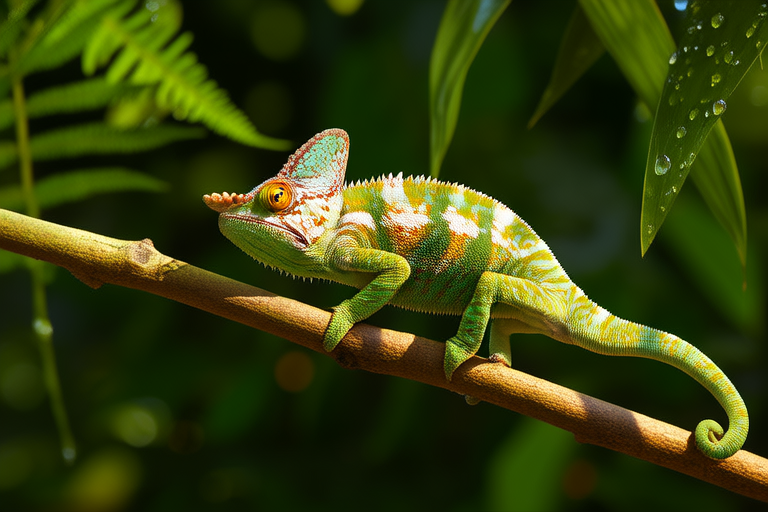
Chameleons: Unique Behaviors, Adaptations, and Care
Chameleons are one of the most fascinating creatures on Earth, known for their remarkable ability to change color, unique anatomy, and intriguing behaviors. These lizards belong to the family Chamaeleonidae and are found across Africa, Madagascar, southern Europe, and some parts of Asia. With over 200 species, chameleons have evolved to thrive in diverse environments, from dense rainforests to arid deserts.
Color-Changing Abilities
The most iconic feature of chameleons is their ability to change color. Contrary to popular belief, they don’t change color to blend into their surroundings but rather to communicate, regulate body temperature, or express emotions. Their skin contains specialized cells called chromatophores, which contain pigments responsible for the color changes. When stimulated by hormones or nerve impulses, these cells expand or contract, altering the visible colors.
Chameleons can display a wide range of colors, including bright greens, reds, and blues, depending on their mood, health, or environment. For example, males may turn vibrant colors during courtship displays or when defending territory against rivals. Females might show darker hues if they’re gravid (carrying eggs) or stressed. This versatile color-changing mechanism allows chameleons to effectively communicate with each other without the need for vocalizations.
Dietary Habits
Chameleons are primarily insectivorous, feeding on a variety of small prey such as crickets, grasshoppers, beetles, and moths. Their diet can vary based on availability and species-specific preferences. Some larger chameleon species may occasionally consume smaller vertebrates like geckos or even nestling birds. In captivity, it’s essential to offer a balanced diet that mimics their natural food sources, supplemented with vitamins and minerals to prevent deficiencies.
One of the most impressive aspects of a chameleon’s hunting technique is its long, sticky tongue, which can extend up to twice the length of its body. The tongue is equipped with a muscular tip covered in microscopic hooks, allowing it to catch insects with remarkable precision. When hunting, a chameleon remains motionless until its prey comes within striking distance. Then, it launches its tongue at lightning speed, capturing the unsuspecting insect before reeling it back into its mouth.
Social Interactions and Survival Strategies
Chameleons are generally solitary animals, preferring to live alone except during mating season. They establish territories and defend them aggressively against intruders. Males often engage in elaborate displays involving head bobbing, puffing out their throats, and showing off their brightest colors to intimidate rivals. Females, on the other hand, are more selective about choosing mates and may reject advances if they’re not in breeding condition.
In the wild, chameleons face numerous threats, including predation by birds of prey, snakes, and mammals. To protect themselves, they rely on their camouflage skills, blending seamlessly with tree bark or leaves. Additionally, some species possess spines along their backs or tails as a deterrent against predators. Chameleons also have an excellent sense of balance, enabling them to perch on narrow branches or twigs without falling.
Anatomy: Eyesight and Tongues
One of the most remarkable features of chameleons is their independent eye movement, allowing them to look in two different directions simultaneously. This adaptation provides them with a nearly 360-degree field of vision, enhancing their ability to detect potential threats or prey. Each eye can rotate up to 180 degrees, giving chameleons a unique advantage in their environment.
Their tongues are another marvel of nature. Not only are they incredibly long but also incredibly fast. A chameleon can shoot its tongue out in less than a tenth of a second, making it one of the fastest movements in the animal kingdom. The tongue’s speed is due to a combination of elastic tissues and muscles that store energy like a spring. When released, this stored energy propels the tongue forward at incredible speeds, ensuring a successful hunt.
Common Misconceptions About Chameleons
Despite their popularity, many people hold misconceptions about chameleons. One common myth is that they change color to match their surroundings perfectly. As mentioned earlier, chameleons use color changes primarily for communication and thermoregulation rather than camouflage. Another misconception is that all chameleons make good pets. While some species can be kept successfully in captivity, others require specific conditions that are difficult to replicate outside their natural habitat.
It’s also important to note that chameleons are not venomous, despite the occasional claim that they are. However, some species do possess mild toxins in their saliva, which may cause localized irritation if bitten. Overall, chameleons are fascinating creatures with unique characteristics that set them apart from other reptiles.
Care in Captivity
For those interested in keeping chameleons as pets, it’s crucial to understand their specific needs and provide an appropriate environment. Chameleons require spacious enclosures with plenty of vertical space, as they are arboreal creatures that spend most of their time climbing trees. The enclosure should be well-ventilated and equipped with branches, vines, and plants to mimic their natural habitat.
Temperature and humidity levels must be carefully controlled to ensure optimal health. Most chameleon species prefer temperatures between 75°F and 90°F (24°C to 32°C), with basking spots reaching up to 100°F (38°C). Humidity levels should be maintained around 50% to 70%, depending on the species. Proper lighting is also essential, as chameleons require UVB light to synthesize vitamin D3 and absorb calcium.
Feeding captive chameleons can be challenging, as they have specific dietary requirements. In addition to providing a varied diet of insects, it’s important to gut-load feeder insects with nutritious foods and dust them with calcium and vitamin supplements. Regular veterinary check-ups are recommended to monitor your chameleon’s health and address any potential issues early.
Handling chameleons should be done with care, as they are delicate creatures that can become stressed easily. It’s best to handle them as little as possible and always support their bodies fully when doing so. Providing a stimulating environment with enrichment activities, such as hiding spots, climbing structures, and novel objects, can help keep your chameleon mentally and physically active.
Conclusion
Chameleons are truly remarkable animals with unique behaviors, adaptations, and survival strategies. From their color-changing abilities to their exceptional eyesight and tongues, these lizards have captivated humans for centuries. Understanding their complex social interactions, dietary habits, and care requirements in captivity can help us appreciate these fascinating creatures even more.
By learning about chameleons, we gain insight into the incredible diversity of life on our planet and the importance of preserving their natural habitats. Whether you’re a seasoned herpetologist or simply curious about these amazing animals, there’s always more to discover about chameleons and the wonders of the natural world.





